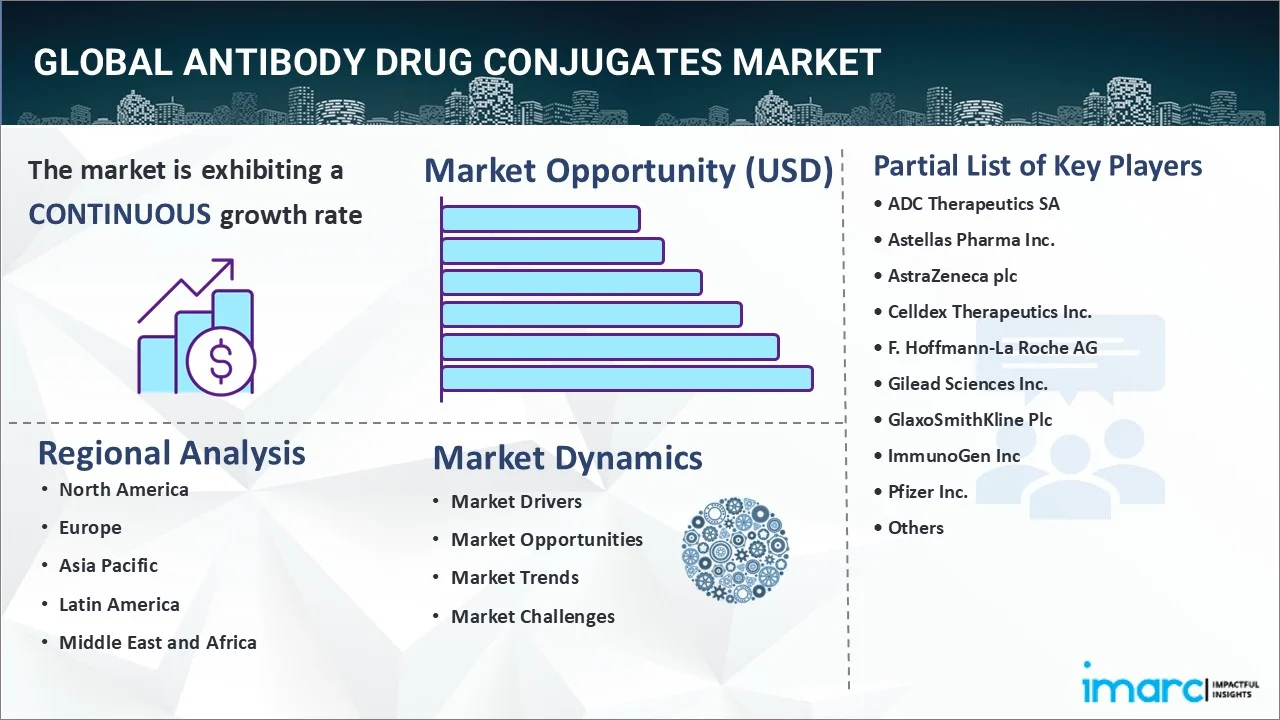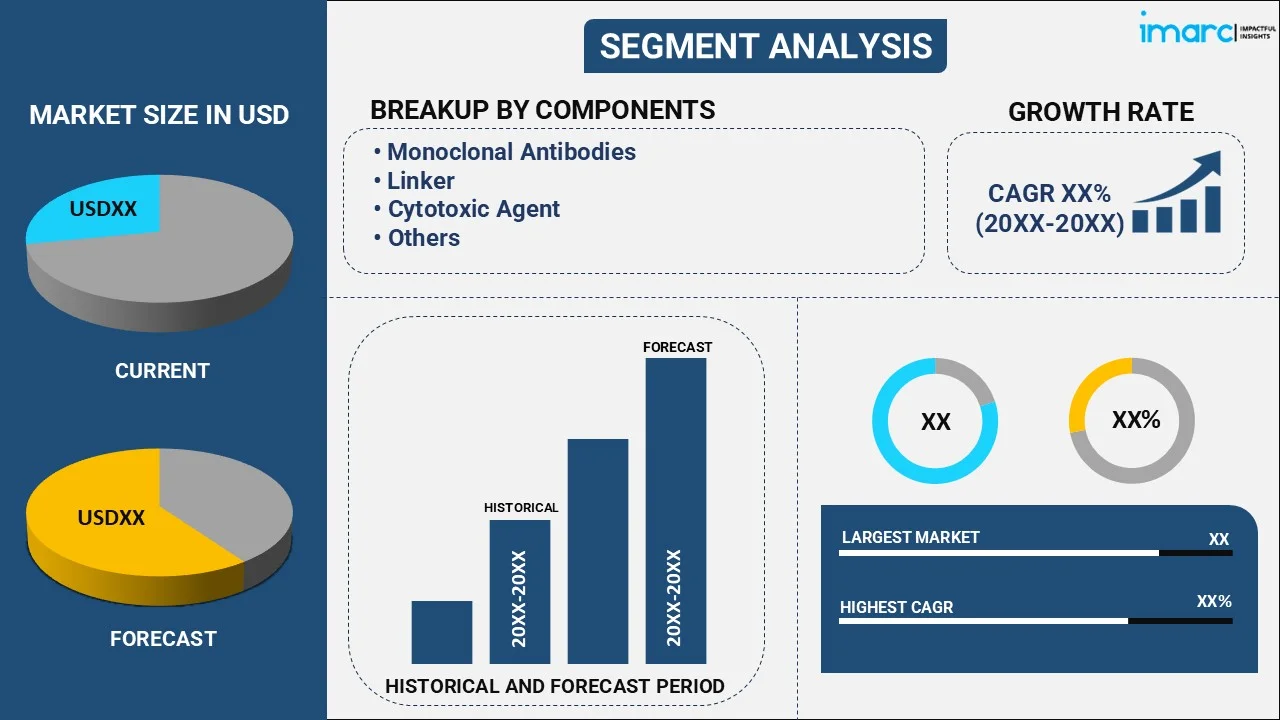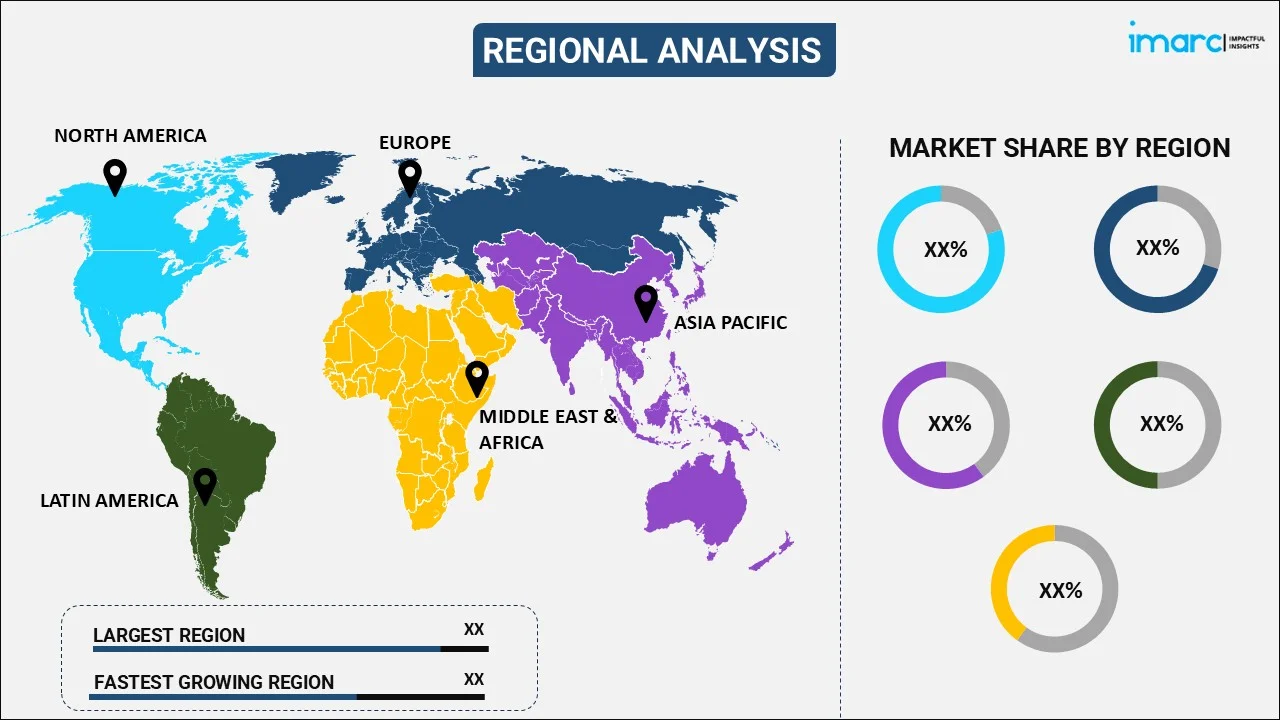
Antibody Drug Conjugates Market Report by Component (Monoclonal Antibodies, Linker, Cytotoxic Agent, and Others), Target (Antibody-Protein Toxin Conjugates, Antibody-Chelated Radionuclide Conjugates, Antibody-Small-Molecule Drug Conjugates, Antibody-Enzyme Conjugates), Application (Lymphoma, Ovarian Cancer, Lung Cancer, Breast Cancer, Brain Tumor, and Others), End User (Hospitals, Specialized Cancer Centers, Academic Research Institutes, Biotechnology Companies, and Others), and Region 2025-2033
Market Overview:
The global antibody drug conjugates market size reached USD 9.4 Billion in 2024. Looking forward, IMARC Group expects the market to reach USD 50.2 Billion by 2033, exhibiting a growth rate (CAGR) of 19.45% during 2025-2033.
|
Report Attribute
|
Key Statistics
|
|---|---|
|
Base Year
|
2024
|
|
Forecast Years
|
2025-2033
|
|
Historical Years
|
2019-2024
|
|
Market Size in 2024
|
USD 9.4 Billion |
|
Market Forecast in 2033
|
USD 50.2 Billion |
| Market Growth Rate 2025-2033 | 19.45% |
Antibody drug conjugates (ADCs) are highly potent biological drugs comprising tumor-targeting antibodies, which are chemically attached to a cytotoxic effector molecule. They deliver cytotoxic anticancer agents to affected cells by connecting them to monoclonal antibodies (mAb) through biodegradable linkers and allowing sensitive bifurcation between healthy and diseased tissues. They assist in increasing the cell-killing potential of mAb, enhancing drug tolerability, and limiting systematic exposure compared to standard chemotherapy bioactive compounds. At present, they are administered intravenously into the bloodstream to avoid gastric acid and proteolytic enzyme degradation of the mAb.

Antibody Drug Conjugates Market Trends:
Due to sedentary lifestyles and the rising number of individuals who smoke and drink regularly, there is an increase in the prevalence of cancer around the world. This, in confluence with the escalating demand for cost-effective and successful cancer treatments, represents one of the key factors bolstering the growth of the market. Apart from this, the existing linkers often release payloads nonspecifically and lead to off-target toxicity, which severely affects the development of ADCs. As a result, leading players are continuously funding their research and development (R&D) projects to optimize the existing chemical triggers and develop novel chemical triggers to generate highly selective linkers. They are also coming up with novel linker-antibody attachments to produce stable and homogenous ADCs and additional linker-payload attachments to allow the expansion of payloads. Moreover, they are focusing on improving the absorption, distribution, metabolism, and excretion, which is creating a favorable market outlook. Other major factors, including considerably improving healthcare infrastructure, increasing awareness about therapies available for cancer treatments, and the introduction of cleavable linker technology, are anticipated to propel the market growth.
Key Market Segmentation:
IMARC Group provides an analysis of the key trends in each sub-segment of the global antibody drug conjugates market report, along with forecasts at the global, regional and country level from 2025-2033. Our report has categorized the market based on component, target, application and end user.
Breakup by Component:

- Monoclonal Antibodies
- Linker
- Cytotoxic Agent
- Others
Breakup by Target:
- Antibody-Protein Toxin Conjugates
- Antibody-Chelated Radionuclide Conjugates
- Antibody-Small-Molecule Drug Conjugates
- Antibody-Enzyme Conjugates
Breakup by Application:
- Lymphoma
- Ovarian Cancer
- Lung Cancer
- Breast Cancer
- Brain Tumor
- Others
Breakup by End User:
- Hospitals
- Specialized Cancer Centers
- Academic Research Institutes
- Biotechnology Companies
- Others
Breakup by Region:

- North America
- United States
- Canada
- Asia-Pacific
- China
- Japan
- India
- South Korea
- Australia
- Indonesia
- Others
- Europe
- Germany
- France
- United Kingdom
- Italy
- Spain
- Russia
- Others
- Latin America
- Brazil
- Mexico
- Others
- Middle East and Africa
Competitive Landscape:
The competitive landscape of the industry has also been examined along with the profiles of the key players being ADC Therapeutics SA, Astellas Pharma Inc., AstraZeneca plc, Celldex Therapeutics Inc., F. Hoffmann-La Roche AG, Gilead Sciences Inc., GlaxoSmithKline Plc, ImmunoGen Inc, Pfizer Inc., Sanofi S.A., Seagen Inc., Sorrento Therapeutics Inc. and Takeda Pharmaceutical Company Ltd.
Report Coverage:
| Report Features | Details |
|---|---|
| Base Year of the Analysis | 2024 |
| Historical Period | 2019-2024 |
| Forecast Period | 2025-2033 |
| Units | Billion USD |
| Segment Coverage | Component, Target, Application, End User, Region |
| Region Covered | Asia Pacific, Europe, North America, Latin America, Middle East and Africa |
| Countries Covered | United States, Canada, Germany, France, United Kingdom, Italy, Spain, Russia, China, Japan, India, South Korea, Australia, Indonesia, Brazil, Mexico |
| Companies Covered | ADC Therapeutics SA, Astellas Pharma Inc., AstraZeneca plc, Celldex Therapeutics Inc., F. Hoffmann-La Roche AG, Gilead Sciences Inc., GlaxoSmithKline Plc, ImmunoGen Inc, Pfizer Inc., Sanofi S.A., Seagen Inc., Sorrento Therapeutics Inc., Takeda Pharmaceutical Company Ltd. |
| Customization Scope | 10% Free Customization |
| Post-Sale Analyst Support | 10-12 Weeks |
| Delivery Format | PDF and Excel through Email (We can also provide the editable version of the report in PPT/Word format on special request) |
Key Questions Answered in This Report:
- How has the global antibody drug conjugates market performed so far and how will it perform in the coming years?
- What has been the impact of COVID-19 on the global antibody drug conjugates market?
- What are the key regional markets?
- What is the breakup of the market based on the component?
- What is the breakup of the market based on the target?
- What is the breakup of the market based on the application?
- What is the breakup of the market based on the end user?
- What are the various stages in the value chain of the industry?
- What are the key driving factors and challenges in the industry?
- What is the structure of the global antibody drug conjugates market and who are the key players?
- What is the degree of competition in the industry?
Need more help?
- Speak to our experienced analysts for insights on the current market scenarios.
- Include additional segments and countries to customize the report as per your requirement.
- Gain an unparalleled competitive advantage in your domain by understanding how to utilize the report and positively impacting your operations and revenue.
- For further assistance, please connect with our analysts.
 Inquire Before Buying
Inquire Before Buying
 Speak to an Analyst
Speak to an Analyst
 Request Brochure
Request Brochure
 Request Customization
Request Customization




.webp)




.webp)












